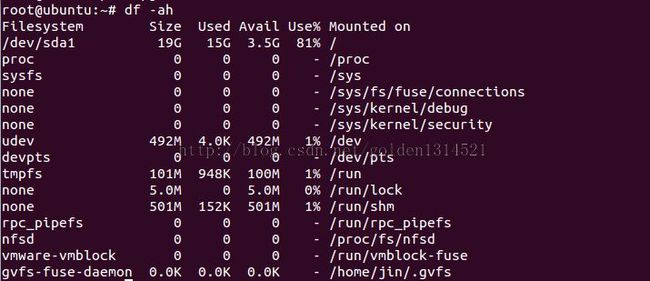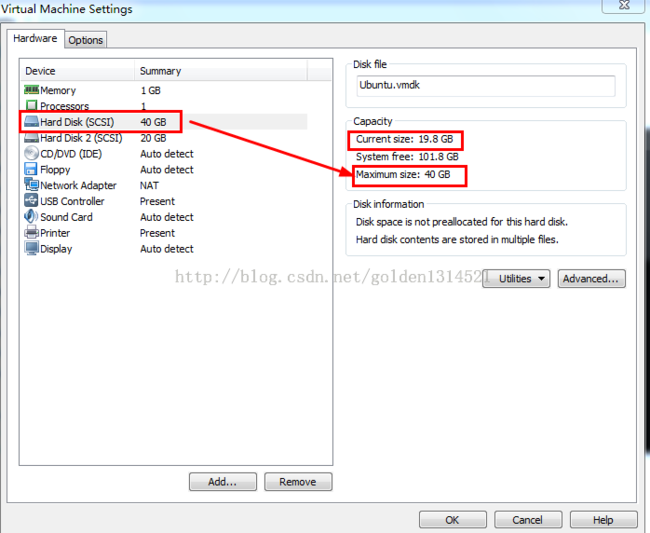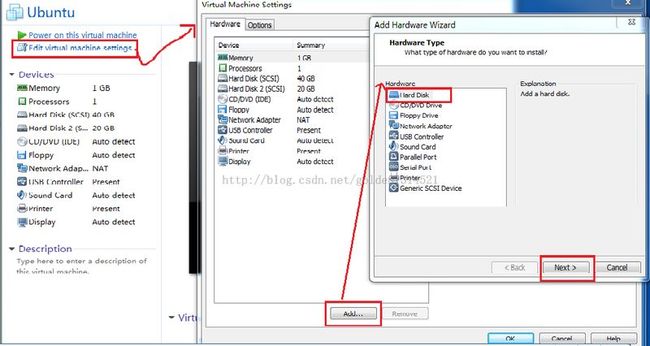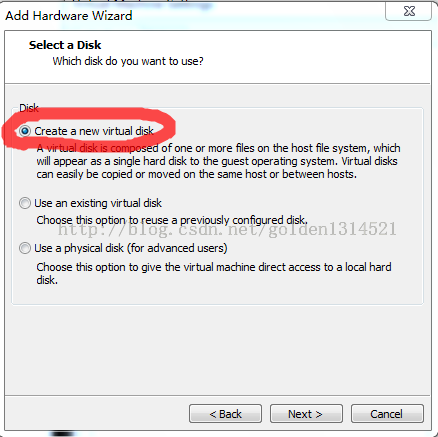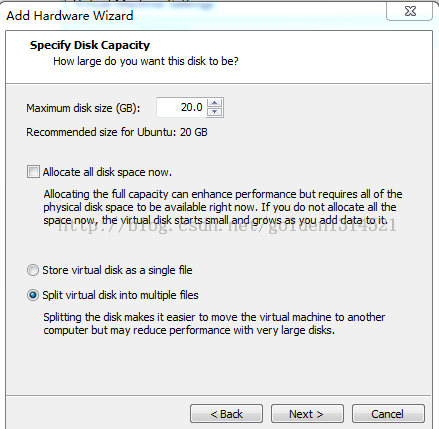VMware虚拟机扩容
作者:金良([email protected]) csdn博客:http://blog.csdn.net/u012176591
用了一段Linux虚拟机,发现安装虚拟机时分配的空间不够用,又不舍得删掉虚拟机重装,毕竟辛辛苦苦在上面装了好多软件,我可不想再为这些配置折腾一番。
怎么办呢,当然是虚拟机扩容。
1.虚拟机所在磁盘空间不够,能够把虚拟机复制到还有一块磁盘里。
2.进入VMware的安装文件夹,在命令提示符后输入"vmware-vdiskmanager",什么參数也不加直接按回车键,可显示这一命令的说明。
3.这一步要关闭虚拟机才行:
扩容命令:C:\Program Files\VMware\VMware Workstation>vmware-vdiskmanager -x 40Gb "D:\Program Files\Virtual Machines\Ubuntu\Ubuntu.vmdk"
參数 "-x" 表示要扩展虚拟机硬盘空间,紧随其后的数字是要扩展到的大小 ( 扩展到 40GB ,包括了原先的磁盘容量 ) 。
重新启动 VMware ,会发现虚拟机硬盘空间已变成 40GB 了
4.运行命令 df -ah查看磁盘情况,发现磁盘空间和扩容前一样,仍是20G:
5.查看分区,运行命令:
fdisk -l以下是当前的磁盘分区表截图,这时我们能够看到磁盘的总量的确添加�到 40GB 了,可是分区仅仅有曾经的那几个原有的分区。
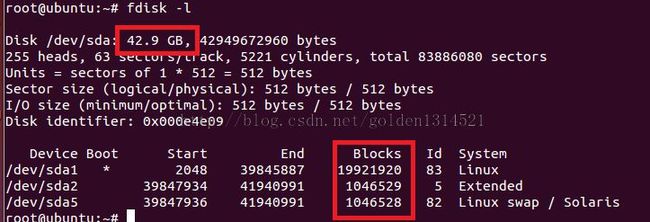
添加�分区过程截图:
重新启动后格式化该分区:
发现一个问题,我命名扩增了20G,为什么新增的分区容量这么小,以至于格式化时提示“Filesystem too small for a journal”
再看虚拟机配置,截图:
图上显示的是:眼下此虚拟硬盘的大小(current size)是19.8G,最大是(maximum size)40G。可是怎么获得这个最大磁盘容量呢?
然后我用了还有一种方法扩容:
与之前的思路不同,本方法不是扩大原来的虚拟磁盘的容量,而是另加一个虚拟磁盘来扩充容量。
第一步、退出Linux虚拟机系统,通过在VMware上对虚拟机进行设置来添加�一块虚拟硬盘。
附截图:
第二步、重新启动Linux虚拟机,对这块虚拟硬盘进行分区、格式化和挂载。
看下磁盘分区情况:
root@ubuntu:/home/now/android4.0.1# fdisk -l Disk /dev/sda: 21.5 GB, 21474836480 bytes 255 heads, 63 sectors/track, 2610 cylinders, total 41943040 sectors Units = sectors of 1 * 512 = 512 bytes Sector size (logical/physical): 512 bytes / 512 bytes I/O size (minimum/optimal): 512 bytes / 512 bytes Disk identifier: 0x000e4e09 Device Boot Start End Blocks Id System /dev/sda1 * 2048 39845887 19921920 83 Linux /dev/sda2 39847934 41940991 1046529 5 Extended /dev/sda5 39847936 41940991 1046528 82 Linux swap / Solaris Disk /dev/sdb: 21.5 GB, 21474836480 bytes 255 heads, 63 sectors/track, 2610 cylinders, total 41943040 sectors Units = sectors of 1 * 512 = 512 bytes Sector size (logical/physical): 512 bytes / 512 bytes I/O size (minimum/optimal): 512 bytes / 512 bytes Disk identifier: 0x00000000 Disk /dev/sdb doesn't contain a valid partition table
这里能够看到/dev/sdb 就是我们新加入�的硬盘,我们须要给新的硬盘分区。
步骤例如以下(看提示):
root@ubuntu:/home/now/android4.0.1# fdisk /dev/sdb
Device contains neither a valid DOS partition table, nor Sun, SGI or OSF disklabel
Building a new DOS disklabel with disk identifier 0x9d6a9772.
Changes will remain in memory only, until you decide to write them.
After that, of course, the previous content won't be recoverable.
Warning: invalid flag 0x0000 of partition table 4 will be corrected by w(rite)
Command (m for help): m
Command action
a toggle a bootable flag
b edit bsd disklabel
c toggle the dos compatibility flag
d delete a partition
l list known partition types
m print this menu
n add a new partition
o create a new empty DOS partition table
p print the partition table
q quit without saving changes
s create a new empty Sun disklabel
t change a partition's system id
u change display/entry units
v verify the partition table
w write table to disk and exit
x extra functionality (experts only)
Command (m for help): n
Partition type:
p primary (0 primary, 0 extended, 4 free)
e extended
Select (default p): p
Partition number (1-4, default 1): 1
First sector (2048-41943039, default 2048):
Using default value 2048
Last sector, +sectors or +size{K,M,G} (2048-41943039, default 41943039):
Using default value 41943039
Command (m for help): p
Disk /dev/sdb: 21.5 GB, 21474836480 bytes
255 heads, 63 sectors/track, 2610 cylinders, total 41943040 sectors
Units = sectors of 1 * 512 = 512 bytes
Sector size (logical/physical): 512 bytes / 512 bytes
I/O size (minimum/optimal): 512 bytes / 512 bytes
Disk identifier: 0x9d6a9772
Device Boot Start End Blocks Id System
/dev/sdb1 2048 41943039 20970496 83 Linux
Command (m for help): w
The partition table has been altered!
Calling ioctl() to re-read partition table.
Syncing disks.
再看磁盘分区,已达到我们想要的结果:
root@ubuntu:/home/now/android4.0.1# fdisk -l Disk /dev/sda: 21.5 GB, 21474836480 bytes 255 heads, 63 sectors/track, 2610 cylinders, total 41943040 sectors Units = sectors of 1 * 512 = 512 bytes Sector size (logical/physical): 512 bytes / 512 bytes I/O size (minimum/optimal): 512 bytes / 512 bytes Disk identifier: 0x000e4e09 Device Boot Start End Blocks Id System /dev/sda1 * 2048 39845887 19921920 83 Linux /dev/sda2 39847934 41940991 1046529 5 Extended /dev/sda5 39847936 41940991 1046528 82 Linux swap / Solaris Disk /dev/sdb: 21.5 GB, 21474836480 bytes 213 heads, 34 sectors/track, 5791 cylinders, total 41943040 sectors Units = sectors of 1 * 512 = 512 bytes Sector size (logical/physical): 512 bytes / 512 bytes I/O size (minimum/optimal): 512 bytes / 512 bytes Disk identifier: 0x9d6a9772 Device Boot Start End Blocks Id System /dev/sdb1 2048 41943039 20970496 83 Linux
我们把新加的磁盘/dev/sdb1 挂载到根分区
root@ubuntu:/home/now# mount /dev/sdb1 / mount: you must specify the filesystem type
系统提示须要明白的文件类型,即我们须要对其进行格式化。
以下是格式化操作:
root@ubuntu:/home/now# mkfs -t ext3 /dev/sdb1 mke2fs 1.42 (29-Nov-2011) Filesystem label= OS type: Linux Block size=4096 (log=2) Fragment size=4096 (log=2) Stride=0 blocks, Stripe width=0 blocks 1310720 inodes, 5242624 blocks 262131 blocks (5.00%) reserved for the super user First data block=0 Maximum filesystem blocks=0 160 block groups 32768 blocks per group, 32768 fragments per group 8192 inodes per group Superblock backups stored on blocks: 32768, 98304, 163840, 229376, 294912, 819200, 884736, 1605632, 2654208, 4096000 Allocating group tables: done Writing inode tables: done Creating journal (32768 blocks): done Writing superblocks and filesystem accounting information: done然后挂载,成功:
root@ubuntu:/home/now# mount /dev/sdb1 / root@ubuntu:/home/now#
查看挂载情况,能够看到/dev/sdb1挂载到了根分区:
root@ubuntu:/home/now# df Filesystem 1K-blocks Used Available Use% Mounted on /dev/sda1 19478204 16257028 2208696 89% / udev 503544 4 503540 1% /dev tmpfs 102472 1108 101364 2% /run none 5120 0 5120 0% /run/lock none 512352 152 512200 1% /run/shm /dev/sdb1 19478204 16257028 2208696 89% /
能够看到这不是我们想要的结果,这是由于“挂载点”必须是一个已经存在的文件夹,这个文件夹能够不为空,但挂载后这个文件夹下曾经的内容将不可用,只是umount以后会恢复正常。
使用卸载命令,发现不能卸载:
root@ubuntu:/# umount /dev/sdb1
umount: /: device is busy.
(In some cases useful info about processes that use
the device is found by lsof(8) or fuser(1))
好在使用mount挂载系统的一个特点是一旦系统重新启动之后就失效,须要又一次挂载。所以我们重新启动就能卸载掉磁盘/dev/sdb1了。
系统重新启动后,在根文件夹下新建一个子文件夹(由于全部的文件夹都是挂载到根文件夹下的),然后把磁盘/dev/sdb1挂载在此文件夹下:
root@ubuntu:/home/now# cd / root@ubuntu:/# mkdir /storehouse root@ubuntu:/# mount /dev/sdb1 /storehouse
查看存储空间利用情况:
root@ubuntu:/# df -h Filesystem Size Used Avail Use% Mounted on /dev/sda1 19G 16G 2.2G 88% / udev 492M 4.0K 492M 1% /dev tmpfs 101M 956K 100M 1% /run none 5.0M 0 5.0M 0% /run/lock none 501M 152K 501M 1% /run/shm /dev/sdb1 20G 173M 19G 1% /storehouse
看到了吧,最后一行就是我们挂载的文件夹。
使用下面试试,往里面拷贝一个压缩文件:
root@ubuntu:/# cp /home/now/android4.0.1.tar.gz /storehouse root@ubuntu:/# ls /storehouse/ android4.0.1.tar.gz lost+found
然后查看存储空间利用情况:
root@ubuntu:/# df -h Filesystem Size Used Avail Use% Mounted on /dev/sda1 19G 16G 2.2G 88% / udev 492M 4.0K 492M 1% /dev tmpfs 101M 968K 100M 1% /run none 5.0M 0 5.0M 0% /run/lock none 501M 152K 501M 1% /run/shm /dev/sdb1 20G 1.9G 17G 11% /storehouse
可以看到可以正常使用。
改动/etc/fstab文件,开机自己主动挂载:
如图,红色方框是我们加入�的


